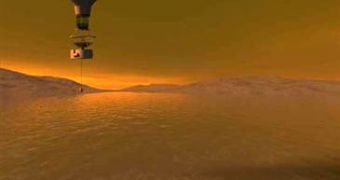Although it's been orbiting Titan, Saturn's biggest moon, for four years now, the Cassini probe hasn't been able to map more than 25% of its surface, because of the atmospheric limitations, as dense fog obscures it from view. Still, together with the Huygens probe, which was sent to roam on the moon, it has helped reshape the view on Titan's surface and potential composition, but in large, the data they've provided only raised more questions than answered the ones already in place.
The atmosphere of Titan was found to be, in spite of previous conceptions, full of nitrogen and very similar to what its Earth counterpart was before the biomass started filling it with oxygen. When Huygens landed, it photographed ice mountains, methane rivers and lakes, but also sandy riverbeds that could trap rovers as it happened to Opportunity. “The ground on Titan may be gooey, and you don't want to get stuck somewhere,” says Athena Coustenis, a Paris Observatory astrophysicist and planetologist, quoted by Space.
This is why she is part of a team that plans to send a hot air balloon on Titan in order to study it closer, as part of a Titan and Saturn System Mission (TSSM) comprising two other elements – a probe and another orbiter. The probe would be moved by means of a helicopter-like rotor and prevented from sinking into methane lakes by floaters. Its scoop would be able to draw liquid and solid samples from Titan's surface. Huygens proved that Titan was not completely covered by a methane ocean, but lacked further analysis instruments, which TSSM could provide instead.
“Huygens was designed as a descent module, and there were no instruments designed to do surface science after landing,” shares Coustenis. “If you ask me what the dunes are made of, I don't know. The only way to find out what the surface is made of is to go touch it, sample it, and have a laboratory there that will analyze all the samples.” Also, a Titan-dedicated orbiter would provide a lot more information than Cassini, which only flies by it at the ecliptic. But whether this mission will be approved or not remains to be seen, since NASA and ESA have to decide early next year between TSSM and another mission that would target Jupiter and its moon Europa.

 14 DAY TRIAL //
14 DAY TRIAL //